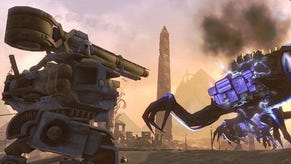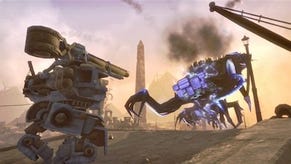Trenched
Mechlovin.
"The enemy crushed my legs, but he couldn't crush my spirit," says a grizzled war veteran at the start of Double Fine's latest downloadable game, Trenched.
This determination is applicable to Double Fine as well, after its metal-themed fantasy epic Brutal Legend was a financial failure. It didn't help that the game was portrayed as an action-adventure title in ads, at trade shows and even in a public demo. When it was finally released as a real-time strategy hybrid, the results were so baffling that its designer Tim Schafer had to write a public letter explaining how to play it properly.
Upon hearing the announcement that Trenched would return to that well for another action/RTS mash-up, one would be forgiven for being sceptical. However, what didn't kill them only made them stronger; Double Fine has learned from its past mistakes to cement its own unique spin on a popular genre.
This isn't immediately apparent, as the studio's penchant for memorable characters and interesting stories is curiously absent. Shortly after World War I, two crippled veterans are privy to a broadcast that imbues each with supernatural intelligence. One decides to use his newfound knowledge to help mankind by building giant piloted mechs; the other decides he'll rule the world by building giant robots. What could be a compelling tale of the futility of war ends up murky and hard to follow.
You play as a soldier of your choice in a state-of-the-art mech known as a trench. At first glance, Trenched could easily be mistaken for a third-person mech combat game, but that's only half of it. The rest is a riff on real-time strategy and its more casual cousin, tower defence. The goal of each level is to protect a base from oncoming waves of enemies. This is done through a combination of shooting them yourself and deploying stationary emplacements to do the rest.
These turrets come in three types: light weapons for shotguns and machine guns, heavy weapons for mortars and mines, and support for dampening generators that slow down enemies or repair cranes to heal damaged trenches. Constructing these costs scrap metal, which must be collected by chiselling it off enemy forces in combat.

It sounds simple, but you can only equip so much when you go into battle, and customising your vehicle for individual missions is key. While your trench has numerous slots for weapons and emplacements, they're not all accessible at once. Various chassis contain different layouts dictating what you can equip. Some grant you access to several weapon slots at the expense of limited emplacements, while others strip you of your firearms to focus on cultivating the battlefield with traps.
It takes a lot of experimentation to find a layout that works, but there are untold strategies for success. The amount of possible trench configurations is dizzying, allowing you to craft the game to your personal play style. Whether you choose to take a more hands-on approach or leave the fighting to your turrets, the game is well balanced and rarely does one side overshadow the other.
Throughout, you gain experience for everything you do, from collecting scrap to machine gun kills to downing enemies using specific types of emplacements. You're even given small doses of experience when your regiment (i.e. those you recently played with) make progress. Larger foes drop boxes of loot and even unsuccessful attempts grant XP, so even when you fail a 15-minute stage, chances are you'll be better equipped next time.











